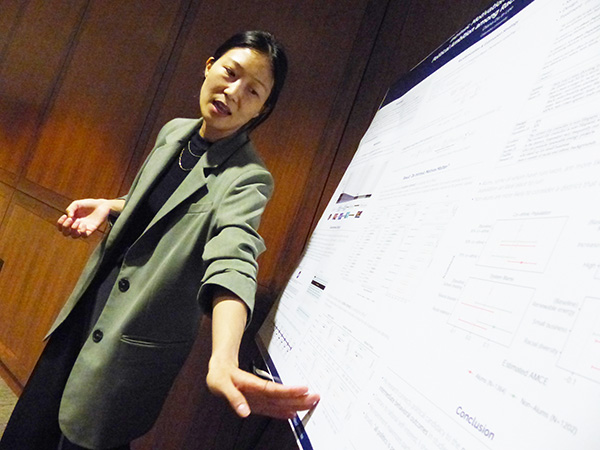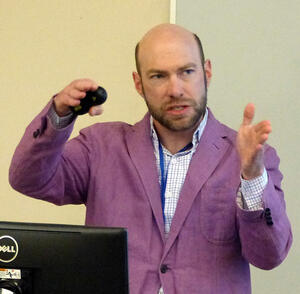Yale Conference Examines How to Gauge Voter Issue Preferences

What do Americans care about?
According to the most recent annual Gallup national issues poll, conducted in March, the number one concern is inflation, followed closely by crime and violence, hunger and homelessness, and the economy. But people answer differently when asked for unprompted responses (immigration comes in first). And very differently based on their political affiliations.
Earlier this month, the Institution for Social and Policy Studies’ Center for the Study of American Politics (CSAP) held a conference exploring what the latest political science research can tell us about public issue preferences.
For example: How can we determine what people want from their government? Are voters up to the task of making meaningful decisions in democratic elections? For those things they care about, do they have sufficiently well-developed preferences for choosing candidates who best represent what they want? Are existing data sufficient to answer these questions? And if not, what can be done?
“What I really like about this conference is gathering a bunch of people who are doing basic research on a common theme but approaching it from a whole variety of perspectives,” said Gregory Huber, director of CSAP, chair of the Political Science Department, and Forst Family Professor of Political Science. “We’ve got researchers who study voter behavior using the tools of formal theory, others who use large scale analysis of survey data, and still others who focus on experimentation — so, a common topic but using a whole range of tools. And when you look around the room, there are new graduate students mixed with faculty members who earned their Ph.D.s in the 90s. It is just an incredibly interesting, accomplished, and diverse group of scholars from all over.”
ISPS advances interdisciplinary research in the social sciences that aims to shape public policy and inform democratic deliberation.
Presentations at the CSAP conference included Christopher Hare of the University of California, Davis (UCD) on reconsidering the role of issue salience in American voting behavior, Erik Snowberg of the University of Utah on the coherence of citizen preferences, Delia Baldassarri of New York University on how independents and moderates make up their minds, Cheryl Boudreau of UCD on the influence of endorsements and donations to political and charitable recipients, Benjamin Lauderdale of University College London on polarization over the priority of political problems, and Chris Tausanovitch of the University of California, Los Angeles on whether there are minorities intense enough to overcome majority preferences.
“I value democracy,” said Lilla Orr, assistant professor of data science and statistics at the University of Richmond, “And I think we have our best shot at successful self-governance if we have some understanding of how people think about politics — how people are reasoning and developing their own choices regarding how to engage with politics.”
Snowberg presented a working paper, written with Huber and Yale Ph.D. student Nicholas Ottone, finding that, in contrast to descriptions of the general public as having no significant policy preferences, about 80% of people surveyed express coherent policy preferences about 80% of the time.

Snowberg contrasted the findings with a conclusion reached by political scientist and sociologist Philip E. Converse in 1964 that “large portions of an electorate do not have meaningful beliefs.” Converse’s statement relies on the fact that voters may not have “constrained” positions, meaning positions that mimic the left-right spectrum occupied by political parties.
“He’s making the argument that somehow constraint is useful,” Snowberg said. “The question to me is: useful for what? My belief is that we should probably be designing institutions for voters rather than voters for institutions.”
Katherine Krimmel, assistant professor of political science at Barnard College, said it might be easier to understand what kind of policy action people think best suits a given problem than getting an accurate sense of which problems they think should be prioritized given the seemingly infinite possibilities.
But she felt that the data show that Americans can have reasonably formed preferences on issues that are important to them, even if their preferences might not align perfectly with the blunt instrument of a single vote they can assign to — usually — one of two viable candidates.
“If you are somebody who has very thoughtful, well-informed preferences about, say, four or five issues, maybe they don’t map onto our partisan landscape cleanly,” Krimmel said. “It can be really challenging for people to locate themselves in the party system we have.”
Between presentations, Lauderdale addressed what happens when people conducting a survey ask questions of people who may not know much about the topics under consideration.
“It’s not easy, because the only way we learn about what people think is to ask them questions, and at the moment you are doing that, you are perhaps taking them out of their natural context of not thinking about politics very much,” Lauderdale said. “I think we are learning something valuable from surveys, but it’s not always what we think we are learning. As political scientists, I think it’s important to be aware of the limitations of that process and work to improve it.”
But even though voters might not always engage deeply with political issues, Lauderdale said most people have figured out what they need to know to vote in a way that makes sense to them.
“They may not be paying a lot of attention to details, but they’ve likely paid enough attention at some point to realize, yeah, I’m probably voting for the Republican, or I’m probably voting for the Democrat,” he said. Because when they’ve paid attention, they’ve tended to agree with one party or the other.”
Tausanovitch said researchers cannot expect voters to know every detail about complex policies, but it’s important to give proper weight to how people’s views can affect their behavior.
“Sometimes we are asking people about things they never thought about before, but other times we are asking about things they have thought about a lot and care very deeply about,” he said. “That is what a lot of this work is getting at, and so I know we can get better.”
Researchers and representatives in government need to understand public views even if the public’s understanding of issues might be incomplete or lacking in nuance, Tausanovitch said.
“We could all think of issues that are way too technocratic for your average voter,” he said. “Nonetheless, the government needs to make choices. And those choices should ideally be in line with voters’ values.”
The goal for political scientists, Tausanovitch said, is to gauge public opinion as accurately as possible as voters respond to how the political system is performing.
“Studying the influence that voters have on the political system, for me, means trying to understand what voters care about,” he said. “And trying to find the areas in which we would actually expect voters’ opinions to make a difference.”